





As a founding employee of Gardener's Supply, I wore many different hats over the years. Currently, I have my own company called Johnnie Brook Creative. The gardens around my home in Richmond, VT, include a large vegetable garden, seasonal greenhouse, cutting garden, perennial gardens, rock garden, shade garden, berry plantings, lots of container plants and a meadow garden. There's no place I'd rather be than in the garden.
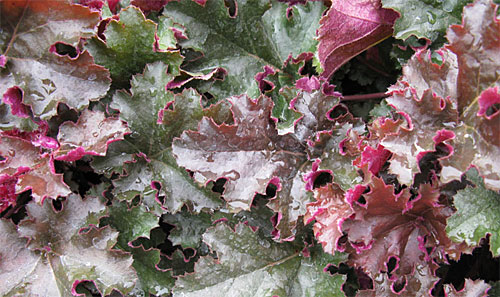
Heucheras make fine plants for shady sites. This variety is called Chocolate Ruffles.
THE once-a-year perennial plant sale at our company's Vermont garden center is a huge event. Shoppers line up well before the 8 a.m. start time, eager to get first shot at the selection. My job is usually to roam the aisles, answering questions. One of the most common questions always goes something like this: “My yard gets lots of shade. What perennials can I plant other than hostas?”
Once I’ve cautioned the person that they’ll be hard-pressed to find another plant as rugged and carefree as a hosta, I tell them about my top 10 easy-care, shade-tolerant perennials. Every one of them is a “good do-er” as my friend Sue would say.
If you have a shady area that could use a little visual excitement, I encourage you to give a couple of these plants a try. You’ll surely find a few that will give those stalwart hostas a run for the money.
Heuchera (Coral bells). Plant breeders have had a field day with the genus heuchera. There seems to be no end to the variations in leaf color: silvery, burgundy, purple-black, chartreuse, salmon and rusty orange. With heuchera, it’s the foliage that provides the visual excitement, though some varieties also have showy flowers on tall, slender stems.
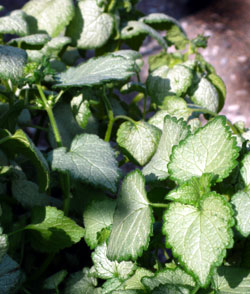
Lamium maculatum (Dead nettle). A low, spreading plant with silvery foliage and purple, pink, red or white blooms in early summer. In shady locations, I find this plant spreads happily—not invasively. If you wind up with too much of it, just give it a tug, lift out a whole section and pass it on to a friend.
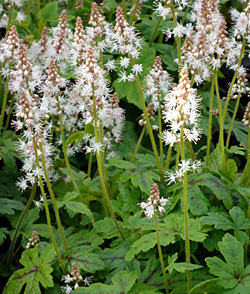
Tiarella cordifolia (Foamflower). Similar to heuchera in leaf and form, tiarella has matte rather than shiny leaves, which gives it a slightly more “natural” look. The bottle-brush flowers are white or pale pink and I find them showier than those of most heucheras. New varieties often feature burgundy-red leaf veins.
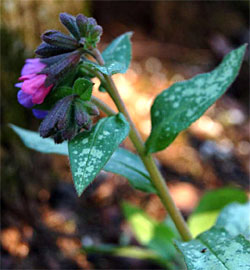
Pulmonaria (Lungwort). Another plant with beautiful silvery foliage. Leaves are typically long and narrow, and may be entirely silver, spotted with silver or randomly splashed with silver. Lungwort flowers in spring and its blossoms are quite showy, ranging in color from white through pink and blue—with different colors often appearing on the same plant.
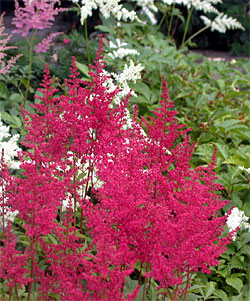
Astilbe. Known best for their colorful flower plumes, many of the newer astilbe varieties also have showy foliage that may be bronze, pale green, blue green, dark green or wine red. If you choose varieties with different foliage colors, bloom times and heights, they can add lots of interesting color and texture throughout the season.
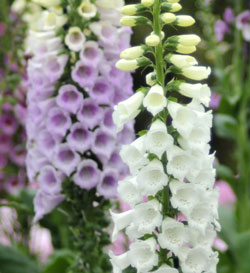
Digitalis (Foxglove). Most foxgloves are biennials, which means they spend their first year growing foliage, their second year flowering and then they die. This may sound troublesome, but the plants usually reseed and sort things out so you wind up having flowers every year. I find Digitalis grandiflora the easiest and most reliable of the bunch.
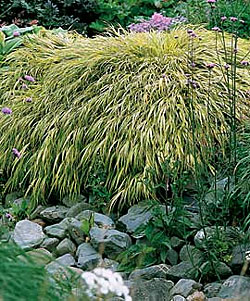
Hakonechloa (Japanese forest grass). Unlike most grasses, this one grows best and looks best in partial shade. It’s short (12-15") and clump-forming, and the narrow leaves have a cascading habit. Depending on the variety, its foliage is golden green, lime green or variegated. Some turn red, orange or purple in the fall.
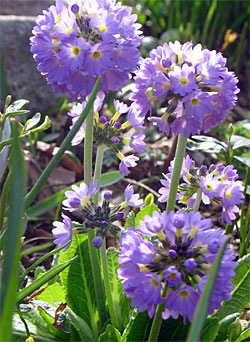
Primula (Primrose). I always thought primroses were difficult to grow, but I’ve found them to be super easy as long as you provide shade and moist soil. There are 425 species of primula. They come in every color of the rainbow and range in size from little 3-inch dwarfs to 4-foot giants. The photo at right shows Primula denticulata, also known as the drumstick primula. Colors range from white through lilac, pink and deep red.
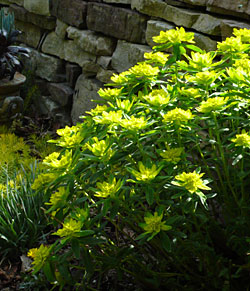
Euphorbia (Spurge). The beautiful, burgundy-leaved Euphorbia dulcis does self sow, but the seedlings can be easily removed (and given to appreciative visitors). I also like Euphorbia polychroma (shown at right), which is a dome of chrome yellow in late spring. In zones 5 and warmer, try Euphorbia polychroma 'Bonfire', which has three seasons of color. There's also a new introduction called Jessie, which grows up to 4 feet tall.
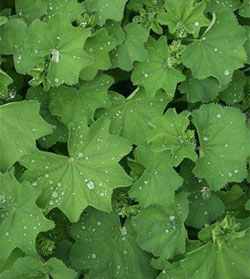
Alchemilla (Lady’s mantle). When water falls on this plant’s pleated leaves, it beads up into dazzling little jewels. The flowers, which appear in early June, are yellow-green and make a fabulous filler for bouquets of almost any color. A very long-lived and trouble-free plant. The standard-size plant is Alchemilla mollis. For small spaces, look for Alchemilla erythropa, which only gets about 6 inches high.
Copyright © www.100flowers.win Botanic Garden All Rights Reserved